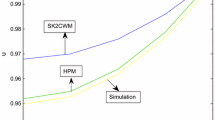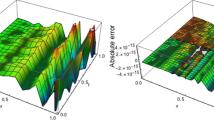Abstract
Fractional reaction–diffusion equations serve as more relevant models for studying complex patterns in several fields of nonlinear sciences. In this paper, we have developed the wavelet methods to find the approximate solutions for the Fitzhugh–Nagumo (FN) and fractional FN equations. The proposed method techniques provide the solutions in rapid convergence series with computable terms. To the best of our knowledge, until now there is no rigorous wavelet solutions have been reported for the FN and fractional FN equations arising in gene propagation and model. With the help of Laplace operator and Legendre wavelets operational matrices, the FN equation is converted into an algebraic system. Finally, we have given some numerical examples to demonstrate the validity and applicability of the wavelet methods. The power of the manageable method is confirmed. Moreover, the use of the wavelet methods is found to be accurate, efficient, simple, low computation costs and computationally attractive.
Similar content being viewed by others
References
S.Z. Rida, A.M.A. El-Sayed, A.A.M. Arafa, On the solutions of time-fractional reaction-diffusion equations. Commun. Nonlinear Sci. Numer. Simul. 5(12), 3847–3854 (2010)
A. Cuyt, L. Wuytack, Nonlinear Methods in Numerical Analysis (Elsevier, Amsterdam, 1987)
J.D. Murray, Lectures on Non-linear Differential Equation Models in Biology (Clarenden, Oxford, 1977)
B.I. Henry, S.L. Wearne, Fractional reaction-diffusion. Physica A 276(3–4), 448–455 (2000)
F.C. Meral, T.J. Royston, R. Magin, Fractional calculus in viscoelasticity: an experimental study. Commun. Nonlinear Sci. Numer. Simul. 15(4), 939–945 (2010)
B. Baeumer, M. Kovács, M.M. Meerschaert, Numerical solutions for fractional reaction-diffusion equations. Comput. Math. Appl. 55(10), 2212–2226 (2008)
M.D. Bramson, Maximal displacement of branching Brownian motion. Commun. Pure Appl. Math. 31(5), 531–581 (1978)
S. Momani, R. Qaralleh, Numerical approximations and Padé approximants for a fractional population growth model. Appl. Math. Model. 31(9), 1907–1914 (2007)
G. Hariharan, The homotopy analysis method applied to the Kolmogorov–Petrovskii–Piskunov (KPP) and fractional KPP equations. J. Math. Chem. 51, 992–1000 (2013). doi:10.1007/s10910-012-0132-5
S.B. Yuste, L. Acedo, K. Lindenberg, Reaction front in an A+B \(\rightarrow \) C reaction-subdiffusion process. Phys. Rev. E. 69(3), part 2, Article ID 036126 (2004)
D.J. Aronson, H.F. Weinberg, Nonlinear Diffusion in Population Genetics Combustion and Never Pulse Propagation (Springer, New York, 1988)
R. Fitzhugh, Impulse and physiological states in theoretical models of nerve membrane. Biophys. J. 1(6), 445–466 (1961)
R. Fitzhugh, Biological Engineering (McGraw-Hill, New York, 1969), pp. 1–85
K. Seki, M. Wojcik, M. Tachiya, Fractional reaction-diffusion equation. J. Chem. Phys. 119, 2165–2174 (2003)
N.A. Khan, N.-U. Khan, A. Ara, M. Jamil, Approximate analytical solutions of fractional reaction-diffusion equations. J. King Saud Univ. Sci. 24, 111–118 (2012)
A. Slavova, P. Zecca, CNN model for studying dynamics and traveling wave solutions of FitzHugh–Nagumo equation. J. Comput. Appl. Math. 151, 13–24 (2003)
A.L. Hodgkin, A.F. Huxley, Aquantitive description of membrane current and its application th conduction and excitation in nerve. J. Physiol. 117, 500 (1952)
A. Panfilov, P. Hogeweg, Spiral breakup in a modified Fitzhugh–Nagumo model. Phys. Lett. A 176, 295–299 (1993)
J.S. Nagumo, S. Arimoto, S. Yoshizawa, An active pulse transmission line simulating nerve axon. Proc. IRE 50, 2061–2071 (1962)
H.C. Rosu, O. Cornejo-Perez, Super symmetric pairing of kinks for polynomial nonlinearities. Phys. Rev. E 71, 1–13 (2005)
G. Hariharan, K. Kannan, Haar wavelet method for solving Fisher’s equation. Appl. Math. Comput. 211, 284–292 (2009)
A.M. Wazwaz, A. Gorguis, An analytical study of Fisher’s equation by using Adomian decomposition method. Appl. Math. Comput. 154, 609–620 (2004)
D. Olmos, B. Shizgal, Pseudospectral method of solution of the Fitzhugh–Nagumo equation. Math. Comput. Simul. 79, 2258–2278 (2009)
D. Olmos, B. Shizgal, A spectral method of solution of Fisher’s equation. J. Comput. Appl. Math. 193, 219–242 (2006)
A.A. Soliman, Numerical simulation of the FitzHugh–Nagumo Equations. Abstr. Appl. Anal. Article ID 762516, (2012) 13 p. doi:10.1155/2012/762516
S.J. Liao, Beyond Perturbation: Introduction to Homotopy Analysis Method (CRC Press/Chapman and Hall, Boca Raton, 2004)
S. Abbasbandy, Soliton solutions for the Fitzhugh–Nagumo equation with the homotopy analysis method. Appl. Math. Model. 32, 2706–2714 (2008)
G. Hariharan, K. Kannan, K. Sharma, Haar wavelet in estimating the depth profile of soil temperature. Appl. Math. Comput. 210, 119–225 (2009)
G. Hariharan, K. Kannan, Haar wavelet method for solving nonlinear parabolic equations. J. Math. Chem. 48, 1044–1061 (2010)
G. Hariharan, K. Kannan, A comparative study of a Haar Wavelet Method and a Restrictive Taylor’s Series Method for solving Convection-diffusion Equations. Int. J. Comput. Methods Eng. Sci. Mech. 11(4), 173–184 (2010)
G. Hariharan, K. Kannan, Haar wavelet method for solving FitzHugh–Nagumo Equation. World Acad. Sci. Eng. Technol. 43, 560–564 (2010)
U. Lepik, Numerical solution of evolution equations by the Haar wavelet method. J. Appl. Math. Comput. 185, 695–704 (2007)
U. Lepik, Solving PDEs with the aid of two-dimensional Haar wavelets. Comput. Math. Appl. 61, 1873–1879 (2011)
H. Jafari, M. Soleymanivaraki, M.A. Firoozjaee, Legendre wavelets for solving fractional differential equations. J. Appl. Math. 7(4), 65–70 (2011, Winter)
Y. Yang, Solving a nonlinear multi-order fractional differential equation using Legendre Pseudo-Spectral method. Appl. Math. 4, 113–118 (2013). doi:10.4236/am.2013.41020
M.H. Heydari, M.R. Hooshmandasl, F.M. Maalek Ghaini, F. Mohammadi, Wavelet collocation method for solving multiorder fractional differential equations. J. Appl. Math. Article ID 54240, (2012). doi:10.1155/2012/542401
H.A. Abdusalam, Analytic and approximate solutions for Nagumo telegraph reaction diffusion equation. Appl. Math. Comput. 157, 515–522 (2004)
D.Y. Chen, Y. Gu, Cole-Hopf quotient and exact solutions of the generalized Fitzhugh-Nagumo equations. Acta Math. Sci. 19(1), 7–14 (1999)
H. Li, Y. Guo, New exact solutions to the Fitzhugh–Nagumo equation. Appl. Math. Comput. 180, 524–528 (2006)
M. Shih, E. Momoniat, F.M. Mahomed, Approximate conditional symmetries and approximate solutions of the perturbed Fitzhugh–Nagumo equation. J. Math. Phys. 46, 023503 (2005)
V. Turut, N. Guzel, Comparing numerical methods for solving time-fractional reaction-diffusion equations. ISRN Mathematical Analysis (2012) Article ID 737206. doi:10.5402/2012/737206
W. Malfliet, Solitary wave solutions of nonlinear wave equations. Am. J. Phys. 60(7), 650–654 (1992)
S.K. Elagan, M. Sayed, Y.S. Hamed, An innovative solutions for the generalized FitzHugh-Nagumo Equation by using the Generalized \(\left( \text{ G }^{\prime }/\text{ G } \right)\)-Expansion Method. Appl. Math. 2, 470–474 (2011)
A. Hajipour, S.M. Mahmoudi, Application of Exp-function method to Fitzhugh–Nagumo equation. World Appl. Sci. J. 9(1), 113–117 (2010)
K. Maleknejad, S. Sohrabi, Numerical solution of Fredholm integral equations of the first kind by using Legendre wavelets. Appl. Math. Comput. 186, 836–843 (2007)
M. Razzaghi, S. Yousefi, The Legendre wavelets operational matrix of integration. Int. J. Syst. Sci. 32, 495–502 (2001)
M. Razzaghi, S. Yousefi, The Legendre wavelets direct method for variational problems. Math. Comput. Simul. 53, 185–192 (2000)
F. Mohammadi, M.M. Hosseini, A new Legendre wavelet operational matrix of derivative and its applications in solving the singular ordinary differential equations. J. Frankl. Inst. 348, 1787–1796 (2011)
H. Parsian, Two dimension Legendre wavelets and operational matrices of integration. Acta Mathematica Academiae Paedagogicae Nyíregyháziensis 21, 101–106 (2005)
S.A. Yousefi, Legendre wavelets method for solving differential equations of Lane–Emden type. App. Math. Comput. 181, 1417–1442 (2006)
F. Yin, J. Song, F. Lu, H. Leng, A coupled method of Laplace transform and legendre wavelets for Lane-Emden-Type differential equations. J. Appl. Math. Article ID 163821 (2012). doi:10.1155/2012/163821
C.F. Chen, C.H. Hsiao, Haar wavelet method for solving lumped and distributed-parameter systems. IEEE Proc. Part D 144(1), 87–94 (1997)
M. Merdan, Solutions of time-fractional reaction-diffusion equation with modified Riemann-Liouville derivative. Int. J. Phys. Sci. 7(15), 2317–2326 (2012)
Author information
Authors and Affiliations
Corresponding author
Appendix
Appendix
1.1 Basic idea of Homotopy analysis method (HAM)
In this section the basic ideas of the HAM are presented. Here a description of the method is given to handle the general nonlinear problem.
where N is a nonlinear operator and \(u_0 (t)\) is unknown function of the independent variable t.
1.2 Zero-order deformation equation
Let \(u_0 (t)\) denote the initial guess of the exact solution of Eq. (7.1), \(\hbox {h}\ne 0\) an auxiliary parameter, \(H(t)\ne 0\) an auxiliary function and L is an auxiliary linear operator with the property.
The auxiliary parameter h, the auxiliary function \(H(t)\), and the auxiliary linear operator \(L\) play an important role within the HAM to adjust and control the convergence region of solution series. Liao [26] constructs, using \(q\in \left[ {0,1} \right] \) as an embedding parameter, the so-called zero-order deformation equation.
where \(\emptyset \left( {t;q} \right) \) is the solution which depends on \(\hbox {h},H\left( t \right) ,L, u_0 (t)\) and q. When q = 0, the zero-order deformation Eq. (7.2) becomes
and when q = 1, since \({\hbox {h}}\ne 0\) and \(H(t)\ne 0\), the zero-order deformation Eq. (7.1) reduces to,
So, \(\emptyset \left( {t;1} \right) \) is exactly the solution of the nonlinear equation. Define the so-called \(m\)th order deformation derivatives.
If the power series Eq. (7.3) of \(\emptyset \left( {t;q} \right) \) converges at q = 1, then we gets the following series solution:
where the terms \(u_m \left( t \right) \) can be determined by the so-called high order deformation described below.
1.3 High-order deformation equation
Define the vector,
Differentiating Eq. (7.3) m times with respect to embedding parameter q, the setting q = 0 and dividing them by \(m!\) , we have the so-called \(m\)th order deformation equation.
where
and
For any given nonlinear operator\(N\), the term \(R_m \left( {\overrightarrow{{u_m }},t} \right) \) can be easily expressed by Eq. (7.11). Thus, we can gain \(u_1 \left( t \right) ,u_2 \left( t \right) \ldots \ldots \). by means of solving the linear high-order deformation with one after the other order in order. The \(m^{th}\) –order approximation of u (t) is given by
ADM, VIM and HPM are special cases of HAM when we set \(h=-1\) and \(H\left( {r,t} \right) =1\). We will get the same solutions for all the problems by above methods when we set \({\hbox {h}}=-1\) and \(H\left( {r,t} \right) =1\). When the base functions are introduced the \(H\left( {r,t} \right) =1\) is properly chosen using the rule of solution expression, rule of coefficient of ergodicity and rule of solution existence.
Rights and permissions
About this article
Cite this article
Hariharan, G., Rajaraman, R. Two reliable wavelet methods to Fitzhugh–Nagumo (FN) and fractional FN equations. J Math Chem 51, 2432–2454 (2013). https://doi.org/10.1007/s10910-013-0220-1
Received:
Accepted:
Published:
Issue Date:
DOI: https://doi.org/10.1007/s10910-013-0220-1




